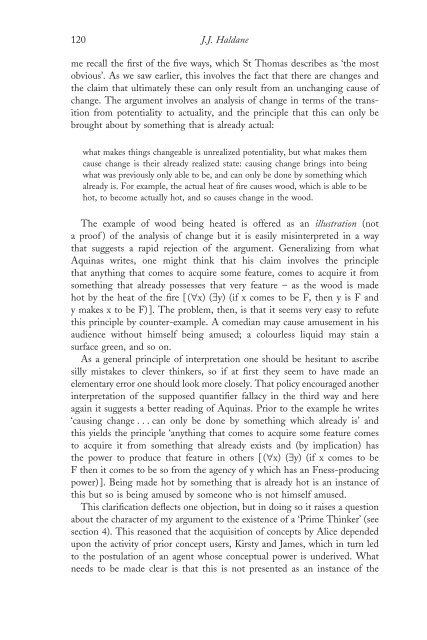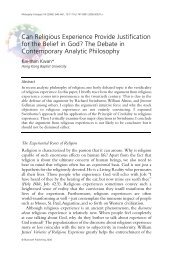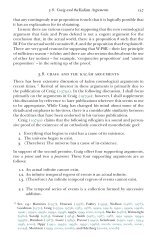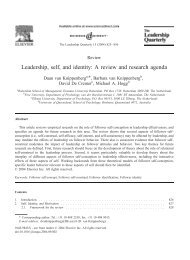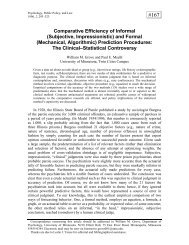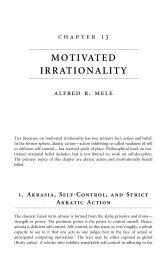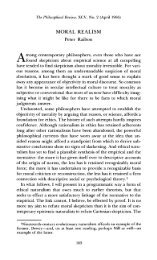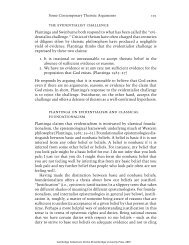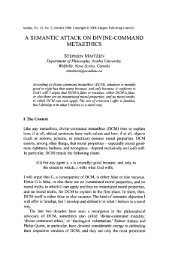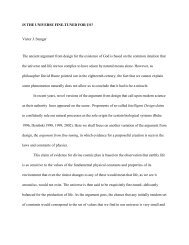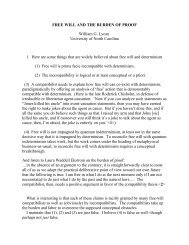Atheism and Theism JJ Haldane - Common Sense Atheism
Atheism and Theism JJ Haldane - Common Sense Atheism
Atheism and Theism JJ Haldane - Common Sense Atheism
You also want an ePaper? Increase the reach of your titles
YUMPU automatically turns print PDFs into web optimized ePapers that Google loves.
120 J.J. <strong>Haldane</strong><br />
me recall the first of the five ways, which St Thomas describes as ‘the most<br />
obvious’. As we saw earlier, this involves the fact that there are changes <strong>and</strong><br />
the claim that ultimately these can only result from an unchanging cause of<br />
change. The argument involves an analysis of change in terms of the transition<br />
from potentiality to actuality, <strong>and</strong> the principle that this can only be<br />
brought about by something that is already actual:<br />
what makes things changeable is unrealized potentiality, but what makes them<br />
cause change is their already realized state: causing change brings into being<br />
what was previously only able to be, <strong>and</strong> can only be done by something which<br />
already is. For example, the actual heat of fire causes wood, which is able to be<br />
hot, to become actually hot, <strong>and</strong> so causes change in the wood.<br />
The example of wood being heated is offered as an illustration (not<br />
a proof ) of the analysis of change but it is easily misinterpreted in a way<br />
that suggests a rapid rejection of the argument. Generalizing from what<br />
Aquinas writes, one might think that his claim involves the principle<br />
that anything that comes to acquire some feature, comes to acquire it from<br />
something that already possesses that very feature – as the wood is made<br />
hot by the heat of the fire [(∀x) (∃y) (if x comes to be F, then y is F <strong>and</strong><br />
y makes x to be F)]. The problem, then, is that it seems very easy to refute<br />
this principle by counter-example. A comedian may cause amusement in his<br />
audience without himself being amused; a colourless liquid may stain a<br />
surface green, <strong>and</strong> so on.<br />
As a general principle of interpretation one should be hesitant to ascribe<br />
silly mistakes to clever thinkers, so if at first they seem to have made an<br />
elementary error one should look more closely. That policy encouraged another<br />
interpretation of the supposed quantifier fallacy in the third way <strong>and</strong> here<br />
again it suggests a better reading of Aquinas. Prior to the example he writes<br />
‘causing change . . . can only be done by something which already is’ <strong>and</strong><br />
this yields the principle ‘anything that comes to acquire some feature comes<br />
to acquire it from something that already exists <strong>and</strong> (by implication) has<br />
the power to produce that feature in others [(∀x) (∃y) (if x comes to be<br />
F then it comes to be so from the agency of y which has an Fness-producing<br />
power)]. Being made hot by something that is already hot is an instance of<br />
this but so is being amused by someone who is not himself amused.<br />
This clarification deflects one objection, but in doing so it raises a question<br />
about the character of my argument to the existence of a ‘Prime Thinker’ (see<br />
section 4). This reasoned that the acquisition of concepts by Alice depended<br />
upon the activity of prior concept users, Kirsty <strong>and</strong> James, which in turn led<br />
to the postulation of an agent whose conceptual power is underived. What<br />
needs to be made clear is that this is not presented as an instance of the


